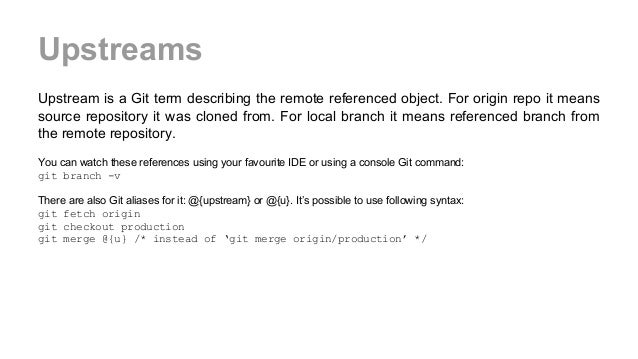

Git tells you about this right in the output for "git status": $ git status This information helps tremendously in staying up-to-date. (b) if there are 4 commits on the remote upstream branch which you haven't pulled yet, then your local branch is "4 commits behind" its upstream branch. (a) if you have 2 commits in your local repository which you haven't pushed to the remote yet, then your local branch is "2 commits ahead" of its upstream branch. Git can now also tell you about unsynced commits which you haven't pushed or pulled, yet. With an upstream branch set, you can simply use the shorthand commands "git pull" and "git push" - instead of having to think about the exact parameters like in "git push origin development". This relationship is very helpful for two reasons: Let's also say that you've set the remote "origin/development" as its upstream branch. Let's say that your current local HEAD branch is named "development". Why should you set up an upstream branch for a local branch? In practice, however, in makes lots of sense to see them as counterparts - connected in a so-called "tracking connection".
#GIT SET UPSTREAM CONSOL CODE#
Run code $Profile in pwsh to open the file in VS Code.In theory, local and remote branches in Git are completely separate items.

(code -locate-shell-integration-path fish)Īdd the following to your PowerShell profile. string match -q " $TERM_PROGRAM " "vscode" and. Run code $_fish_config_dir/config.fish in fish to open the file in VS Code.

⚠️ This is currently experimental and automatic injection is not supportedĪdd the following to your config.fish. "$(code -locate-shell-integration-path bash)"

Run code ~/.bashrc in bash to open the file in VS Code. Tip: When using the Insiders build, replace code with code-insiders below.Īdd the following to your ~/.bashrc file.
#GIT SET UPSTREAM CONSOL INSTALL#
When using manual install it's recommended to set to false, though not mandatory.
#GIT SET UPSTREAM CONSOL HOW TO#
Where and how to do this depends on the shell and OS you're using. To manually install shell integration, the VS Code shell integration script needs to run during your shell's initialization. You may still be able to manually install to get it working. Note: Automatic injection may not work on old versions of the shell, for example older versions of fish do not support the $XDG_DATA_DIRS environment variable which is how injection works. The recommended way to enable shell integration for those is manual installation. This standard, easy way will not work for some advanced use cases like in sub-shells, through a regular ssh session (when not using the Remote - SSH extension) or for some complex shell setups. This automatic injection can be disabled by setting to false. This is done by injecting arguments and/or environment variables when the shell session launches. This additional information enables some useful features such as working directory detection and command detection, decorations, and navigation.īy default, the shell integration script should automatically activate on supported shells launched from VS Code. Visual Studio Code has the ability to integrate with common shells, allowing the terminal to understand more about what's actually happening inside the shell.


 0 kommentar(er)
0 kommentar(er)
